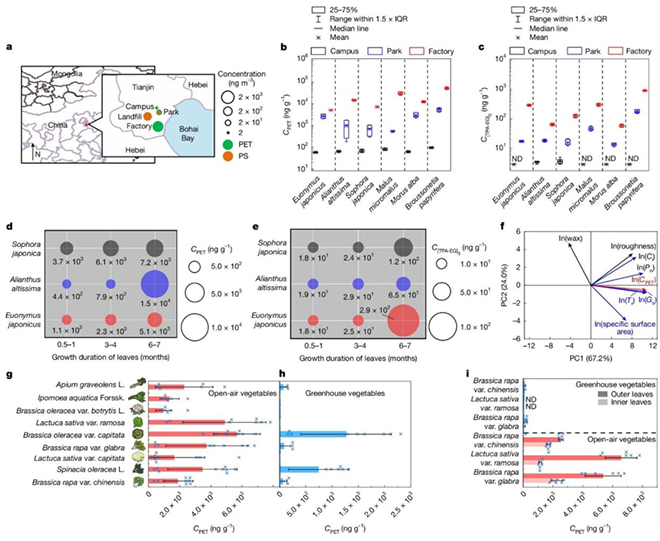
Figure Concentrations of the target microplastics in leaves and vegetables in the atmosphere in Tianjin. a, The location of the sampling sites in Tianjin, China and the atmospheric concentration (ng m-3 DW) of PET and PS polymers. b,c, The concentrations (ng g-1 DW) of PET polymer (b) and oligomer [TPA-EG]3 (c) in the leaves of six independent plants at three different sites (campus, park, and factory). d – f, Varied concentrations of PET (d) and [TPA-EG]3 (e) in leaves of different growth duration, as well as the relationship between the PET concentration in leaves and the leaf physiological characteristics identified by principal component analysis (PCA) (f). g – i, The average concentrations (ng g-1) of PET in the open-air-planted vegetables (g) and greenhouse vegetables (h), and the difference between the outer and inner leaves of vegetables (i). For d – f, average values are shown. In g and f, n = 6 independent biological individuals of Brassica oleracea var. botrytis L., Ipomoea aquatica Forssk., and Apium graveolens L. in both open-air and greenhouse environments; n = 9 independent biological individuals of B. rapa var. chinensis, Spinacia oleracea L., L. sativa var. capitata, B. rapa var. glabra, B. oleracea var. capitata, and L. sativa var. ramosa in both open-air and greenhouse environments. Vegetable samples were collected from 6 independent biological individuals (n = 6) (i).
With the support of grants from the National Natural Science Foundation of China (Approval Nos. 42077336, 42177373) and the National Key Research and Development Program of China, Professor Lei Wang and Professor Hongwen Sun's team at Nankai University, in collaboration with Professor Baoshan Xing at the University of Massachusetts Amherst and other partners, have made progress in studying microplastics accumulation in plant. The related research findings, titled ‘Leaf absorption contributes to accumulation of microplastics in plants’, were published in Nature on April 9, 2025. Paper link: https://www.nature.com/articles/s41586-025-08831-4.
Plant absorption is an important pathway for pollutants to enter the food chain. Microplastics absorbed by plant roots are influenced by mechanisms such as the Casparian strip blockade, resulting in low transport efficiency to the aerial parts of the plant and limited risk of entering the food chain. Microplastics are widely present in the atmospheric environment, exhibiting regional migration capabilities and a particle size distribution lower than that in soil and water environments. High-dose exposure experiments have shown that plant leaves can directly absorb nanosized plastic microspheres. However, due to the small particle size of microplastics in the atmospheric environment, the characterization of microplastics absorbed by plant leaves is challenging. As a result, there has been a lack of convincing evidence for direct absorption of atmospheric microplastics by plant leaves in natural environments.
The research team conducted field investigations and laboratory simulation studies on the potential absorption behavior of plant leaves toward microplastics in the atmospheric environment, selecting typical areas such as Dacron factories and landfills. Using self-developed techniques such as ‘chemical depolymerization-monomer mass spectrometry detection,’ they quantitatively characterized the pollution levels of polyethylene terephthalate (PET) and polystyrene (PS) microplastics and plastic oligomers in tree leaves. They found that the concentrations of PET and PS polymers in some plant leaves could reach up to 104 ng/g, with significant correlations with leaf growth duration, leaf gas exchange capacity, and atmospheric pollution levels. Employing hyperspectral imaging (HSI) and atomic force microscope-infrared spectroscopy (AFM-IR), they observed absorbed polymer composite particles of PET, PS, nylon (PA), and polyvinyl chloride (PVC) in field-collected plant leaves. Various exposure experiments were conducted using field-collected dust, fluorescently labeled microplastic particles, and europium-labeled microplastic particles. Using HSI, confocal laser scanning microscopy, and laser ablation inductively coupled plasma mass spectrometry, the research revealed that microplastics are absorbed by plant leaf stomata, transported to vascular tissues via the apoplastic pathway, and accumulated in leaf trichomes.
This study overcame the technical challenges of qualitative and quantitative characterization of microplastics in the field scale plant samples through mass spectrometry and spectroscopy. It confirmed that plant leaves widely possess the ability to absorb microplastics from the atmospheric environment and elucidated the absorption, transport, and accumulation pathways of microplastics by plant leaves using labeled particle in-situ tracing methods. The research revealed that the absorption of microplastics from the atmospheric environment by plant leaves is an important pathway for environmental microplastics to enter the food chain, advancing the cognitive progress in the field of microplastics pollution research and representing another leading achievement by China in this research area.

Add: 83 Shuangqing Rd., Haidian District, Beijing, China
Postcode: 100085
Tel: 86-10-62327001
Fax: 86-10-62327004
E-mail: bic@turningpointcsc.org
京ICP备05002826号 文保网安备1101080035号 Copyright 2017 NSFC, All Right Reserved